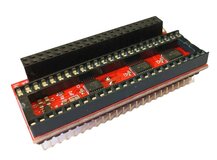
Accelerators and RAM cards for Commodore Amiga
Boost your Amiga's performance and capability with our range of RAM expansions and accelerators. Floating Point Units (FPU), Real Time Clock and Sensors are available to add to our Amiga expansions.
Jargon Buster
Are you confused by some of the terms used with Amiga accelerators and memory expansions? We have explained some of the key terms here to help.
Accelerator: upgrade board for your Amiga that increases the speed and performance by upgrading the Amiga's CPU.
Memory: programs are stored temporarily in memory, or RAM while they are running. Additional memory is needed for more complex programs. Memory is erased every time the Amiga is reset or powered down.
Chip Memory: a special type of memory used by the Amiga's graphics and sound chips- sometimes referred to as Graphics Memory or Chip RAM.
CPU (Central Processing Unit): This is the "brain" of the Amiga- the microchip that controls the entire computer system. CPUs found in the Amiga and accelerators have part numbers which increase according to their speed and performance. The slowest CPU is the 68000 used in the Amiga 500, 1000 and 2000. The fastest CPU is the 68060, used in high performance accelerators. In between there are the 68020, 68030 and 68040 models of CPU.
Floating Point Unit (FPU): a special co-processor that can calculate floating point mathematics, taking the burden off main Central Processing Unit (CPU). Useful for 3D graphics rendering applications.
Real Time Clock (RTC): the Real Time Clock stores and updates the current time and date even when the Amiga is powered down due to it being self-powered by a small battery. The Amiga time and date stamps files when they are created or updated.
Megahertz (Mhz): Each model of CPU can also tolerate a maximum speed that it can reliably operate within which is shown in megahertz(mhz). The greater the megahertz rating, the faster the CPU will compute data. The CPU will get hotter as it operates at high frequencies and may need additional cooling to operate reliably and does not fail.
Trapdoor Slot: If you turn an Amiga 1200, 600 or 500 over you will see a plastic door (the "trapdoor"). Using a small coin to lever it open which will reveal an expansion slot. For the Amiga 500 and 600, memory expansions can be plugged in here. On the Amiga 1200, both memory expansions and accelerators can be installed in the trapdoor.
Category
Manufacturers
- A-Eon Technolog..
- ACT-Electronic ..
- ACube Systems S..
- Alinea Computer
- Amiga.org
- amigakit.com
- APC & TCP
- Clickboom
- Commodore Busin..
- DCE Computer Se..
- E3B
- Elbox Computer
- Entwickler-X
- Great Valley Pr..
- Individual Comp..
- Logic3
- Matay
- Quickshot
- Rabbit Hole Com..
- Retro 7-bit
- RuneSoft
- Saitek
- Samsung
- SpeedLink
- Terratec
- Variant Press
- Varisys Ltd
- Vulcan Software
Quick Find
Information





















